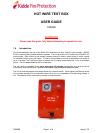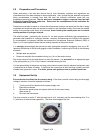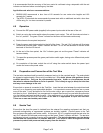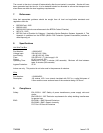
TM0098 Page 2 of 4 Issue 1.00
2.0 Preparation and Precautions
When performing a hot wire test, ensure that all local standards, practices and regulations are
understood and have been adhered to where applicable. Also, ensure that the detection equipment
being proved/tested is isolated from both the local fire authority notification alerts and any
suppressant actioning devices. The hot wire test is intended to trigger a response from the High
Sensitivity Smoke Detectors under test. Ensure that the consequences of this activation are
understood and under control.
Precautions must also be taken to ensure that all personnel present are aware that the test is being
conducted and that those who are required to remain in the immediate vicinity of the test are suitably
attired for the smoke levels about to be created. Avoid inhaling the smoke plume as it contains
small quantities of hydrogen chloride.
The wire burn tests, particularly the 1m and 2 x 1m tests, produce sufficiently high temperatures to
generate small quantities of hydrogen chloride. However, test personnel are unlikely to be exposed
to concentrations of hydrogen chloride that exceed the Occupational Exposure Standard (OES) of
5ppm in a 15 minute period unless they are directly exposed to the smoke plume.
It is strongly recommended that personnel wear appropriate protective equipment such as an E1
respirator conforming to EN140 and goggles, without ventilation, conforming to EN166 in the following
situations:
• Multiple tests are required
• Personnel are within the immediate vicinity (e.g. 2m) of the smoke source
Due to the nature of hot wire tests there is a minor fire hazard. It is essential that an appropriate type
of fire extinguisher (e.g. C0
2 or Dry Powder) is available during the test.
It is the responsibility of the person carrying out the tests to ensure that the electrical equipment used
is maintained at all times for safety. In particular the correct fuse is fitted and that a power cord with
suitable local approvals is used. If in doubt, please seek guidance from a qualified electrician.
3.0 Equipment Set-Up
Ensure that the fuse fitted has the correct rating. If the fuse is not the correct rating for the supply
voltage in use then it must be replaced as follows:
1. Turn the unit off and disconnect the power supply cord
2. Eject the fuse drawer
3. Remove the existing fuse and replace with one of the correct rating
(See section 8)
4. Re-insert the fuse drawer
The timer must be in mode “C” with the scale set to “min” (minutes) and the scale showing from “0 to
3” (maximum of three minutes operation). The timer should appear like this:






